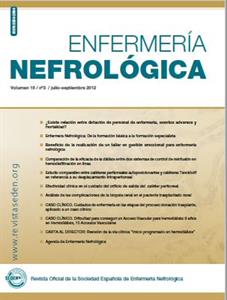Contenido del artículo principal
Resumen
Palabras clave
Detalles del artículo
Derechos de autor 2012 Mª Carmen Salvador Lengua, Mª José Folch Morro, Alexandra Mallol Domínguez, Jorge Bort Castelló, Elena Mª Renau Ortells, Vicente Cerrillo García, Carmen Aicart Saura

Esta obra está bajo una licencia internacional Creative Commons Atribución-NoComercial 4.0.
Aviso de derechos de autor/a
© Los autores ceden de forma no exclusiva los derechos de explotación de los trabajos publicados y consiente en que su uso y distribución se realice con la Licencia Creative Commons Atribución - No comercial 4.0 Internacional (CC BY-NC 4.0). Puede consultar desde aquí la versión informativa y el texto legal de la licencia. Esta circunstancia ha de hacerse constar expresamente de esta forma cuando sea necesario.
Referencias
- M. García Martínez, Mª Teresa Sola García, Raquel Pelayo Alonso. La posición del catéter de diálisis peritoneal no es esencial para un correcto funcionamiento. En: Libro de comunicaciones presentadas al XXXIII Congreso Nacional Seden. SEDEN 2008.
- B. Millán Díaz, M. J. Castro vilanova, M. Hidalgo Díaz. Catéter autoposicionante. Experiencia clínica y estudio comparativo con el catéter tenckhoff. En: Libro de comunicaciones presentadas al XXXIII. Congreso Nacional Seden. SEDEN 2008.
- Cavagna R; Tessarin C; Tarroni G. The self-locating catheter: clinical evaluation and comparison with the Tenckhoff catheter. Perit Dial Int 1999 NovDec;19(6):540-3.
- Di Paolo N; Capotondo L; Sansoni E; Romolini V. The self-locating catheter: clinical experience and follow-up. Perit Dial Int 2004 JulAug;24(4):359-64.
- R. Rivas Martín, M.I. Sánchez Martín. Diálisis Peritoneal. En: Tratado de Enfermería en cuidados críticos pediátricos y neonatales (ECCPN).Capítulo 143 [acceso el 30 de Julio de 2012]. Disponible en: http://www.eccpn.aibarra.org/temario/sección9.htm
- J. L. Martín Espejo. Catéteres peritoneales. Tipos de catéteres Protocolos de implantación de catéteres peritoneales del grupo de D.P. de Andalucía. En: Diálisis Peritoneal. IV Curso andaluz de diálisis peritoneal para enfermería. Seden 2006. Cap. 5 (32-41).
Referencias
M. García Martínez, Mª Teresa Sola García, Raquel Pelayo Alonso. La posición del catéter de diálisis peritoneal no es esencial para un correcto funcionamiento. En: Libro de comunicaciones presentadas al XXXIII Congreso Nacional Seden. SEDEN 2008.
B. Millán Díaz, M. J. Castro vilanova, M. Hidalgo Díaz. Catéter autoposicionante. Experiencia clínica y estudio comparativo con el catéter tenckhoff. En: Libro de comunicaciones presentadas al XXXIII. Congreso Nacional Seden. SEDEN 2008.
Cavagna R; Tessarin C; Tarroni G. The self-locating catheter: clinical evaluation and comparison with the Tenckhoff catheter. Perit Dial Int 1999 NovDec;19(6):540-3.
Di Paolo N; Capotondo L; Sansoni E; Romolini V. The self-locating catheter: clinical experience and follow-up. Perit Dial Int 2004 JulAug;24(4):359-64.
R. Rivas Martín, M.I. Sánchez Martín. Diálisis Peritoneal. En: Tratado de Enfermería en cuidados críticos pediátricos y neonatales (ECCPN).Capítulo 143 [acceso el 30 de Julio de 2012]. Disponible en: http://www.eccpn.aibarra.org/temario/sección9.htm
J. L. Martín Espejo. Catéteres peritoneales. Tipos de catéteres Protocolos de implantación de catéteres peritoneales del grupo de D.P. de Andalucía. En: Diálisis Peritoneal. IV Curso andaluz de diálisis peritoneal para enfermería. Seden 2006. Cap. 5 (32-41).




